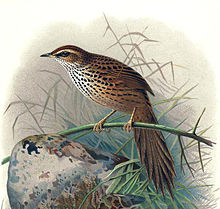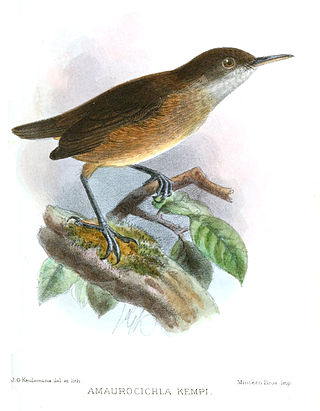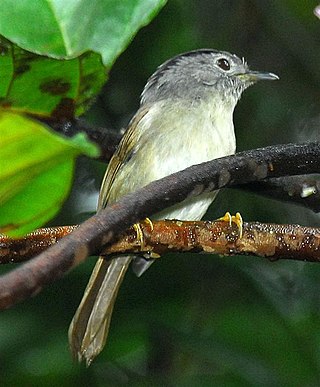Species
Family Sylviidae sensu stricto
True warblers (or sylviid warblers) and parrotbills. A fairly diverse group of smallish taxa with longish tails. Mostly in Asia, to a lesser extent in Africa. A few range into Europe; one monotypic genus on the west coast of North America.
- Genus Sylvia – typical warblers (6 species)
- Eurasian blackcap, Sylvia atricapilla
- Garden warbler, Sylvia borin
- Dohrn's warbler, Sylvia dohrni
- Abyssinian catbird, Sylvia galinieri
- Bush blackcap, Sylvia nigricapillus
- African hill babbler, Sylvia abyssinica
- Genus Curruca – 27 species. Formerly in Sylvia (Sylviidae) [3]
- Barred warbler, Curruca nisoria
- Layard's warbler, Curruca layardi
- Banded parisoma, Curruca boehmi
- Chestnut-vented warbler, Curruca suboerulea
- Desert whitethroat, Curruca minula
- Lesser whitethroat, Curruca curruca
- Hume's whitethroat, Curruca althaea
- Brown parisoma, Curruca lugens
- Yemen warbler, Curruca buryi
- Arabian warbler, Curruca leucomelaena
- Western orphean warbler, Curruca hortensis
- Eastern orphean warbler, Curruca crassirostris
- African desert warbler, Curruca deserti
- Asian desert warbler, Curruca nana
- Tristram's warbler, Curruca deserticola
- Menetries's warbler, Curruca mystacea
- Rüppell's warbler, Curruca ruppeli
- Cyprus warbler, Curruca melanothorax
- Sardinian warbler, Curruca melanocephala
- Western subalpine warbler, Curruca iberiae
- Moltoni's warbler, Curruca subalpina
- Eastern subalpine warbler, Curruca cantillans
- Common whitethroat, Curruca communis
- Spectacled warbler, Curruca conspicillata
- Marmora's warbler, Curruca sarda
- Dartford warbler, Curruca undata
- Balearic warbler, Curruca balearica
Moved to family Paradoxornithidae [3]

- Genus Lioparus – golden-breasted fulvetta
- Genus Chrysomma
- Yellow-eyed babbler, Chrysomma sinense
- Jerdon's babbler, Chrysomma altirostre
- Genus Rhopophilus
- Tarim babbler, Rhopophilus albosuperciliaris
- Beijing babbler, Rhopophilus pekinensis
- Genus Fulvetta
- Spectacled fulvetta, Fulvetta ruficapilla
- Indochinese fulvetta, Fulvetta danisi
- Chinese fulvetta, Fulvetta striaticollis
- White-browed fulvetta, Fulvetta vinipectus
- Brown-throated fulvetta, Fulvetta ludlowi
- Manipur fulvetta, Fulvetta manipurensis
- Grey-hooded fulvetta, Fulvetta cinereiceps
- Genus Chamea – wrentit
- Genus Paradoxornis
- Black-breasted parrotbill, Paradoxornis flavirostris
- Spot-breasted parrotbill, Paradoxornis guttaticollis
- Genus Conostoma – great parrotbill
Moved to family Pellorneidae
- Genus Graminicola
- Rufous-rumped grassbird ("-babbler") Graminicola bengalensis
Moved to family Cisticolidae
- Genus Bathmocercus – rufous-warblers
- Black-capped rufous-warbler, Bathmocercus cerviniventris
- Black-faced rufous-warbler, Bathmocercus rufus
- Genus Sceptomycter – sometimes merged into Bathmocercus. Cisticolidae?
- Mrs Moreau's warbler, Sceptomycter winifredae
- Genus Poliolais – Cisticolidae or more basal like bulbuls?
- White-tailed warbler, Poliolais lopezi
- Two to 14 of the 15 tailorbirds
Moved to family Acrocephalidae

Marsh and tree warblers or acrocephalid warblers. Usually rather large "warblers", most are olivaceous brown above with much yellow to beige below. Usually in open woodland, reed beds or tall grass. Mainly southern Asia to western Europe and surroundings ranging far into Pacific, some in Africa. The genus limits are seriously in need of revision; either most species are moved into Acrocephalus, or the latter is split up though there is presently insufficient knowledge as to how.
- Genus Acrocephalus – marsh warblers (about 35 species)
- Genus Hippolais – tree warblers (8 species)
- Genus Chloropeta – yellow warblers (3 species)
- Genus Nesillas – brush warblers (4 living species, 1 recently extinct)
Moved to Malagasy warblers
See Cibois et al. (2001)
- Genus Thamnornis
- Thamnornis, Thamnornis chloropetoides
- Genus Cryptosylvicola
- Cryptic warbler, Cryptosylvicola randriansoloi
Moved to family Locustellidae

Grass warblers and allies. Mid-sized and usually long-tailed species; sometimes strongly patterned but generally very drab in overall colouration. Often forage on the ground. Old World and into Australian region, centred on the Indian Ocean; possibly also one species in South America. A not too robustly supported clade that requires further study.
- Genus Bradypterus – megalurid bush-warblers (11 species)
- Genus Locustella – grass warblers (more than 20 species)
- Genus Megalurus – typical grassbirds (10 species)
- Genus Amphilais – grey emutail
- Genus Elaphrornis – Sri Lanka bush warbler
- Genus Schoenicola – (2 species)
- Genus Buettikoferella – buff-banded thicketbird
- Genus Chaetornis – bristled grassbird
The black-capped donacobius, Donacobius atricapillus, which was long considered an aberrant wren or mockingbird is apparently quite closely related, and might possibly be considered the only American species of this family.
Moved to family Cettiidae
Typical bush warblers and relatives or cettiid warblers. Another group of generally very drab species, tend to be smaller and shorter-tailed than Megaluridae. Usually frequent shrubland and undergrowth. Continental Asia, and surrounding regions, ranging into Africa and southern Europe.
- Genus Pholidornis – formerly in Remizidae; tentatively placed here
- Tit hylia, Pholidornis rushiae
- Genus Hylia – tentatively placed here [4]
- Green hylia, Hylia prasina
- Genus Abroscopus – Abroscopus warblers
- Rufous-faced warbler, Abroscopus albogularis
- Yellow-bellied warbler, Abroscopus superciliaris
- Black-faced warbler, Abroscopus schisticeps

- Genus Erythrocercus – monarch-warblers. Formerly Monarchinae.
- Chestnut-capped flycatcher, Erythrocercus mccallii
- Little yellow flycatcher, Erythrocercus holochlorus
- Livingstone's flycatcher, Erythrocercus livingstonei
- Genus Urosphena – stubtails
- Timor stubtail, Urosphena subulata
- Babar stubtail, Urosphena subulata advena – extinct (mid-20th century)
- Bornean stubtail, Urosphena whiteheadi
- Asian stubtail, Urosphena squameiceps
- Pale-footed bush warbler, Urosphena pallidipes
- Neumann's warbler, Urosphena neumanni
- Timor stubtail, Urosphena subulata
- Genus Tesia – tesias
- Javan tesia, tesia superciliaris
- Slaty-bellied tesia, Tesia olivea
- Grey-bellied tesia, Tesia cyaniventer
- Russet-capped tesia, Tesia everetti
- Genus Horornis – bush warblers (some 13 species).
- Genus Cettia – bush warblers (4 species).
- Genus Tickellia
- Broad-billed warbler, Tickellia hodgsoni
- Genus Phyllergates
- Mountain tailorbird, Phyllergates cucullatus
- Rufous-headed tailorbird, Phyllergates heterolaemus
Moved to family Aegithalidae
- Genus Leptopoecile – tit-warblers. Tentatively placed there.
- White-browed tit-warbler, Leptopoecile sophiae
- Crested tit-warbler, Leptopoecile elegans
Moved to family Phylloscopidae
Leaf warblers or phylloscopes. A group very variable in size, often vivid green colouration above and yellow below, or more subdued with greyish-green to greyish-brown plumage. Catch food on the wing fairly often. Eurasia, ranging into Wallacea and Africa.

- Genus Phylloscopus – leaf warblers (c. 55 species). (includes former genus Seicercus [5] )
- Green-crowned warbler, Phylloscopus burkii
- Grey-crowned warbler, Phylloscopus tephrocephalus
- Whistler's warbler, Phylloscopus whistleri
- Bianchi's warbler, Phylloscopus valentini
- Martens's warbler, Phylloscopus omeiensis
- Alström's warbler, Seicercus soror
- White-spectacled warbler, Phylloscopus affinis – paraphyletic
- Bar-winged white-spectacled warbler, Seicercus (affinis) intermedius
- Grey-cheeked warbler, Phylloscopus poliogenys
- Chestnut-crowned warbler, Phylloscopus castaniceps
- Yellow-breasted warbler, Phylloscopus montis
- Sunda warbler, Phylloscopus grammiceps
Moved to family Macrosphenidae
African warblers. Also "Sphenoeacus group". An assemblage of usually species-poor and apparently rather ancient "odd warblers" from Africa. Ecomorphologically quite variable. Monophyly requires confirmation.
- Genus Sylvietta – crombecs
- Green crombec, Sylvietta virens
- Lemon-bellied crombec, Sylvietta denti
- White-browed crombec, Sylvietta leucophrys
- Chapin's crombec, Sylvietta (leucophrys) chapini – possibly extinct (late 20th century?)
- Northern crombec, Sylvietta brachyura
- Philippa's crombec, Sylvietta philippae
- Red-capped crombec, Sylvietta ruficapilla
- Red-faced crombec, Sylvietta whytii
- Somali crombec, Sylvietta isabellina
- Long-billed crombec, Sylvietta rufescens
- Genus Melocichla
- Moustached grass warbler, Melocichla mentalis
- Genus Achaetops
- Rockrunner, Achaetops pycnopygius
- Genus Sphenoeacus
- Cape grassbird, Sphenoeacus afer
- Genus Cryptillas.
- Victorin's warbler, Cryptillas victorini
- Genus Macrosphenus – longbills
- Kemp's longbill, Macrosphenus kempi
- Yellow longbill, Macrosphenus flavicans
- Grey longbill, Macrosphenus concolor
- Pulitzer's longbill, Macrosphenus pulitzeri
- Kretschmer's longbill, Macrosphenus kretschmeri
"Sylviidae" incertae sedis
Taxa that have not been studied. Most are likely to belong to one of Sylvioidea families listed above. Those in the Australian-Pacific region are probably Megaluridae. These taxa are listed in the sequence used in recent years.
- Genus Dromaeocercus – emutails. Locustelidae?
- Brown emutail, Dromaeocercus brunneus
- Grey emutail, Dromaeocercus seebohmi – sometimes separated in Amphilais
- Genus Phyllolais – Cisticolidae?
- Buff-bellied warbler, Phyllolais pulchella
- Genus Graueria
- Grauer's warbler, Graueria vittata
- Genus Eremomela – eremomelas. Cettiidae?
- Salvadori's eremomela, Eremomela salvadorii
- Yellow-vented eremomela, Eremomela flavicrissalis
- Yellow-bellied eremomela, Eremomela icteropygialis
- Senegal eremomela, Eremomela canescens
- Green-backed eremomela, Eremomela pusilla
- Green-capped eremomela, Eremomela scotops
- Yellow-rumped eremomela, Eremomela gregalis
- Rufous-crowned eremomela, Eremomela badiceps
- Turner's eremomela, Eremomela turneri
- Western Turner's eremomela, Eremomela turneri kalindei – probably extinct (early 1980s?)
- Black-necked eremomela, Eremomela atricollis
- Burnt-neck eremomela, Eremomela usticollis
- Genus Randia – Malagasy warblers?
- Rand's warbler, Randia pseudozosterops
- Genus Bowdleria – fernbirds. Sometimes merged into Megalurus. Locustellidae?
- Fernbird, Bowdleria punctata
- Chatham fernbird, Bowdleria rufescens – extinct (c. 1900)
- Genus Chaetornis – bristled grassbird. Locustellidae?
- Genus Schoenicola – grassbirds. Basal Locustellidae?
- Broad-tailed grassbird, Schoenicola platyura
- Fan-tailed grassbird, Schoenicola brevirostris
- Genus Cincloramphus – songlarks. Basal Locustellidae?
- Brown songlark, Cincloramphus cruralis
- Rufous songlark, Cincloramphus mathewsi
- Genus Buettikoferella – probably Locustellidae
- Buff-banded bushbird, Buettikoferella bivittata
- Genus Megalurulus – thicketbirds. Probably Locustellidae
- New Caledonian grassbird, Megalurulus mariei
- Bismarck thicketbird, Megalurulus grosvenori
- Bougainville thicketbird, Megalurulus llaneae
- Santo thicketbird, Megalurulus whitneyi
- Rusty thicketbird, Megalurulus rubiginosus
- Genus Trichocichla – long-legged warbler
Not in Sylvioidea
Entirely unrelated songbirds hitherto placed in Sylviidae
- Genus Amaurocichla – Apparently a Passeroidea; very close to, or part of the Motacillidae [6]
- Bocage's longbill or São Tomé short-tail, Amaurocichla bocagei
- Genus Stenostira – Together with some "odd flycatchers", they form the new family Stenostiridae. They are closely related to Paridae (Beresford et al. 2005)
- Fairy flycatcher, Stenostira scita
- Genus Hyliota – hyliotas. Basal Passerida with no known relatives, perhaps somewhat closer to Promeropidae (sugarbirds) [7]
- Yellow-bellied hyliota, Hyliota flavigaster
- Southern hyliota, Hyliota australis
- Usambara hyliota, Hyliota usambarae
- Violet-backed hyliota, Hyliota violacea
- Genus Newtonia – newtonias. Now in Vangidae (vangas); possibly polyphyletic (Yamagishi et al. 2001)
- Dark newtonia, Newtonia amphichroa
- Common newtonia, Newtonia brunneicauda
- Archbold's newtonia, Newtonia archboldi
- Red-tailed newtonia, Newtonia fanovanae – tentatively placed here












